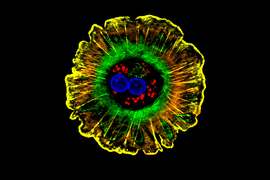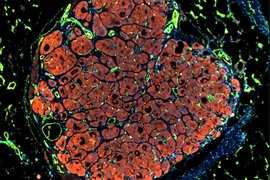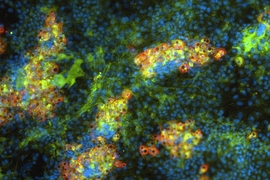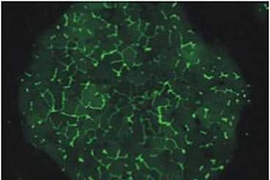Giving drugs at different times of day could significantly affect how they are metabolized in the liver, according to a new study from MIT.
Using tiny, engineered livers derived from cells from human donors, the researchers found that many genes involved in drug metabolism are under circadian control. These circadian variations affect how much of a drug is available and how effectively the body can break it down. For example, they found that enzymes that break down Tylenol and other drugs are more abundant at certain times of day.
Overall, the researchers identified more than 300 liver genes that follow a circadian clock, including many involved in drug metabolism, as well as other functions such as inflammation. Analyzing these rhythms could help researchers develop better dosing schedules for existing drugs.
“One of the earliest applications for this method could be fine-tuning drug regimens of already approved drugs to maximize their efficacy and minimize their toxicity,” says Sangeeta Bhatia, the John and Dorothy Wilson Professor of Health Sciences and Technology and of Electrical Engineering and Computer Science at MIT, and a member of MIT’s Koch Institute for Integrative Cancer Research and the Institute for Medical Engineering and Science (IMES).
The study also revealed that the liver is more susceptible to infections such as malaria at certain points in the circadian cycle, when fewer inflammatory proteins are being produced.
Bhatia is the senior author of the new study, which appears today in Science Advances. The paper’s lead author is Sandra March, a research scientist in IMES.
Metabolic cycles
It is estimated that about 50 percent of human genes follow a circadian cycle, and many of these genes are active in the liver. However, exploring how circadian cycles affect liver function has been difficult because many of these genes are not identical in mice and humans, so mouse models can’t be used to study them.
Bhatia’s lab has previously developed a way to grow miniaturized livers using liver cells called hepatocytes, from human donors. In this study, she and her colleagues set out to investigate whether these engineered livers have their own circadian clocks.
Working with Charles Rice’s group at Rockefeller University, they identified culture conditions that support the circadian expression of a clock gene called Bmal1. This gene, which regulates the cyclic expression of a wide range of genes, allowed the liver cells to develop synchronized circadian oscillations. Then, the researchers measured gene expression in these cells every three hours for 48 hours, enabling them to identify more than 300 genes that were expressed in waves.
Most of these genes clustered in two groups — about 70 percent of the genes peaked together, while the remaining 30 percent were at their lowest point when the others peaked. These included genes involved in a variety of functions, including drug metabolism, glucose and lipid metabolism, and several immune processes.
Once the engineered livers established these circadian cycles, the researchers could use them to explore how circadian cycles affect liver function. First, they set out to study how time of day would affect drug metabolism, looking at two different drugs — acetaminophen (Tylenol) and atorvastatin, a drug used to treat high cholesterol.
When Tylenol is broken down in the liver, a small fraction of the drug is converted into a toxic byproduct known as NAPQI. The researchers found that the amount of NAPQI produced can vary by up to 50 percent, depending on what time of day the drug is administered. They also found that atorvastatin generates higher toxicity at certain times of day.
Both of these drugs are metabolized in part by an enzyme called CYP3A4, which has a circadian cycle. CYP3A4 is involved in processing about 50 percent of all drugs, so the researchers now plan to test more of those drugs using their liver models.
“In this set of drugs, it will be helpful to identify the time of the day to administer the drug to reach the highest effectiveness of the drug and minimize the adverse effects,” March says.
The MIT researchers are now working with collaborators to analyze a cancer drug they suspect may be affected by circadian cycles, and they hope to investigate whether this may also be true of drugs used in pain management.
Susceptibility to infection
Many of the liver genes that show circadian behavior are involved in immune responses such as inflammation, so the researchers wondered if this variation might influence susceptibility to infection. To answer that question, they exposed the engineered livers to Plasmodium falciparum, a parasite that causes malaria, at different points in the circadian cycle.
These studies revealed that the livers were more likely to become infected after exposure at different times of day. This is due to variations in the expression of genes called interferon-stimulated genes, which help to suppress infections.
“The inflammatory signals are much stronger at certain times of days than others,” Bhatia says. “This means that a virus like hepatitis or parasite like the one that causes malaria might be better at taking hold in your liver at certain times of the day.”
The researchers believe this cyclical variation may occur because the liver dampens its response to pathogens following meals, when it is typically exposed to an influx of microorganisms that might trigger inflammation even if they are not actually harmful.
Bhatia’s lab is now taking advantage of these cycles to study infections that are usually difficult to establish in engineered livers, including malaria infections caused by parasites other than Plasmodium falciparum.
“This is quite important for the field, because just by setting up the system and choosing the right time of infection, we can increase the infection rate of our culture by 25 percent, enabling drug screens that were otherwise impractical,” March says.
The research was funded by the MIT International Science and Technology Initiatives MIT-France program, the Koch Institute Support (core) Grant from the U.S. National Cancer Institute, the National Institute of Health and Medical Research of France, and the French National Research Agency.











